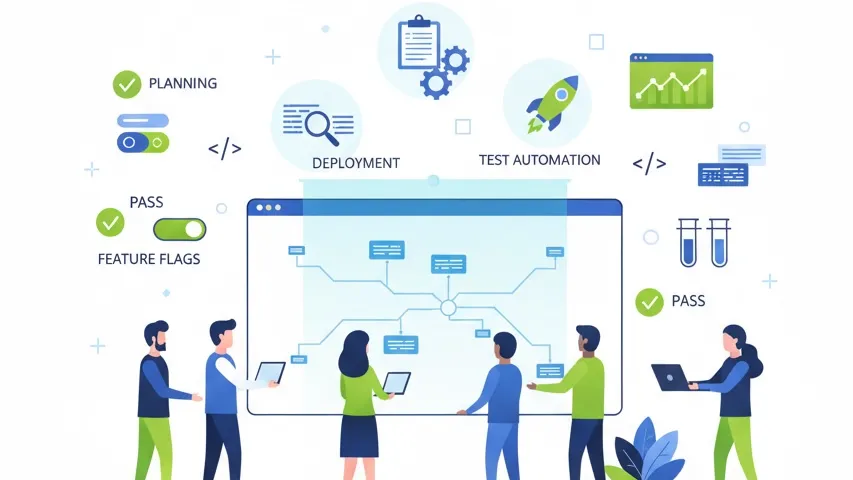Engineering Best Practices: A Guide to Shipping Quality Software

Building great software isn’t just about writing code—it’s about following a disciplined process that ensures quality, alignment, and successful delivery. Here are the essential practices every engineering team should embrace.
Start with Understanding
Before you write a single line of code, make sure you truly understand what you’re building. This means grasping both the product vision and the specific change you’re working on. Take time to analyze the current state of the system, identify what needs to change, and understand the dependencies and potential impact of those changes. You’d be surprised how many projects go sideways simply because engineers jumped into implementation without this foundational understanding.
Equally important is ensuring that everyone agrees on what success looks like. Get alignment from all stakeholders—product managers, designers, other engineers, and management—on how you’ll measure whether the feature actually works and delivers value.
Plan Before You Build
When facing substantial changes or multiple unknowns that could significantly impact direction, build a prototype first. This helps you validate assumptions and explore different approaches without committing to a full implementation.
Once you have clarity, write a proposal and get your team to review it. This isn’t bureaucracy—it’s insurance. You need buy-in from both engineering and management before starting significant work. Define clear milestones and ensure they align with management expectations. Sometimes there’s a valuable opportunity on the horizon, like landing a new client, and certain features become more critical than others.
Build Iteratively
Implement features iteratively and merge often. Use feature flags to hide unfinished parts rather than maintaining long-lived feature branches that diverge from the main codebase. Long-lived branches are a recipe for painful merge conflicts and integration headaches.
Code Review Done Right
Code reviews are essential for catching issues and keeping the team informed about changes that might impact them. Here’s a pro tip: use AI tools for initial code review to catch all the low-hanging fruit—formatting issues, obvious bugs, simple improvements. Then, when you engage your teammates, they can focus on the harder-to-spot issues that leverage their experience with the product and technology. Don’t waste their time with obvious mistakes.
Testing Is Not Optional
Testing should be considered part of your development effort, not an afterthought. There’s an ongoing debate between Test-Driven Development (writing tests before implementation) and Testable Code (writing tests after implementation). Here’s the truth: don’t get too bothered by this debate. The priority is having well-structured code that’s easy to test.
For experienced engineers who design testable code upfront, it matters less when the tests are actually written. But gaining this intuition requires experience, so apply both methodologies to develop your instincts for testable code.
Always run tests as part of Pull Requests, and treat failed tests seriously. Engineers should never merge PRs with failing tests—this discipline is what keeps your codebase reliable.
Continuous Delivery
Build your applications for every pull request and every merge to main, but separate these builds strategically. Pull Request builds should be for the development team’s eyes only, while Main merge builds should be visible to internal management, especially those interested in specific features.
For clients who hired development team: Don’t overwhelm them by pushing too many versions. Instead, establish an agreement to provide new versions once or twice a week. Then simply select the most appropriate version from your Main merge builds and expose it to them. This creates a predictable cadence that clients appreciate and gives you room to iterate rapidly internally.
For end-users: Deliver often to keep the product fresh and responsive to user needs. In-progress features should be part of the build but hidden behind feature flags—this keeps your main branch healthy and deployable at all times. Always perform sanity checking before each release to catch any obvious issues that automated tests might have missed. A quick manual verification of critical user flows can save you from embarrassing production incidents.
Roll Out Gradually
Make sure you have targeting and segmentation sorted out before launch. Use feature flags to gradually roll out changes—test them internally first, then slowly expand to production users through measured steps like 10% → 25% → 50% → 100%. This approach is especially critical for mobile and desktop applications, where delivering a new version can easily take days, unlike web applications where changes are instant.
Observability Is Part of the Product
Every new feature should have logging implemented from the start. Logging and monitoring aren’t afterthoughts—they’re essential parts of development. Never roll out a feature without a proper dashboard.
For internal testing, it’s acceptable to have only the most important monitoring in place. But before production rollout, comprehensive monitoring must be available. You need to see what’s happening in real-time.
Alert Before Problems Escalate
You absolutely do not want an angry client telling you that a feature hasn’t worked for the last five days. Make sure failure cases are tracked in your dashboard, but since nobody monitors dashboards 24/7, add automatic email alerting when critical failures occur or success rates drop below expected minimums. Proactive alerting is the difference between you discovering issues and your users discovering them for you.
Make Debugging Possible with Tracing
No matter how careful you are, bugs will happen in production. That’s just reality. What matters is how quickly you can identify and fix them. Implement tracing across your entire stack so you can track issues from frontend to backend. This cross-system visibility is essential for quickly identifying root causes and dramatically reduces the time from “something’s broken” to “here’s the fix.”
The Bottom Line
These practices might seem like overhead when you’re eager to ship features quickly, but they’re actually the foundation of speed. Teams that skip these practices spend far more time dealing with production issues, miscommunication, and rework than they ever saved by cutting corners. The fastest teams are the ones who build quality in from the start.